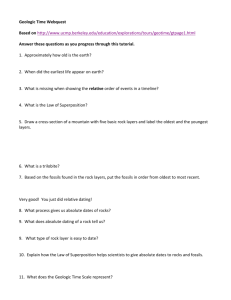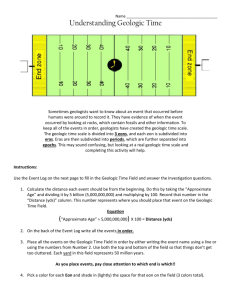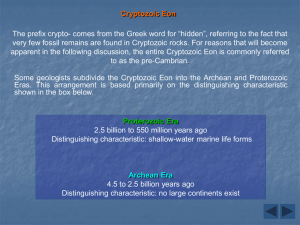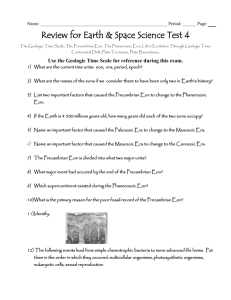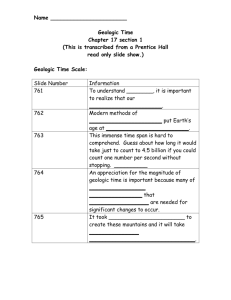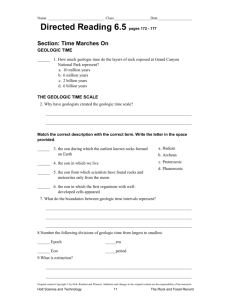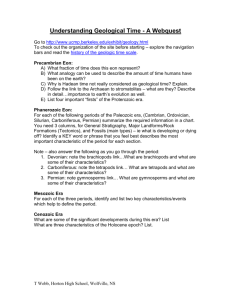MS Science - Blountstown Middle School
advertisement
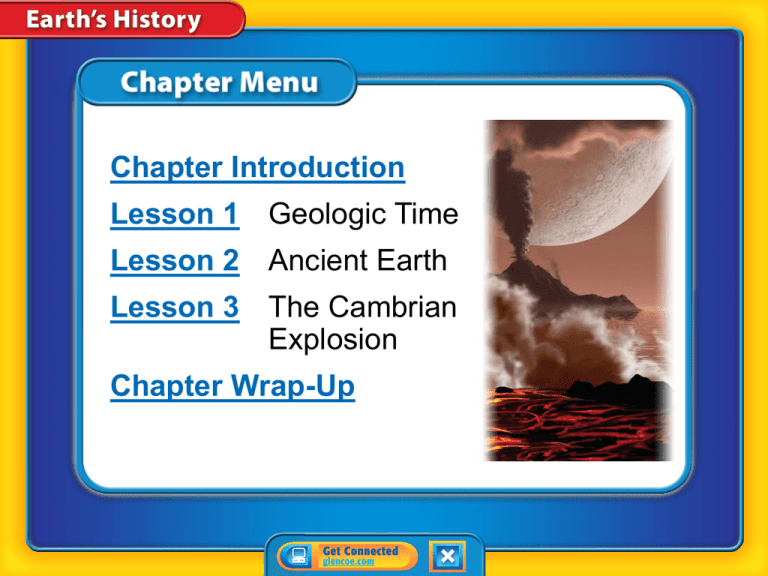
Chapter Introduction Lesson 1 Geologic Time Lesson 2 Ancient Earth Lesson 3 The Cambrian Explosion Chapter Wrap-Up How have natural events changed Earth over time? What do you think? Before you begin, decide if you agree or disagree with each of these statements. As you view this presentation, see if you change your mind about any of the statements. Do you agree or disagree? 1. All rocks contain fossils. 2. Humans produce all radioactive materials. 3. When Earth first formed, oceans were much larger than they are today. 4. Earth’s early atmosphere was different from Earth’s present-day atmosphere. Do you agree or disagree? 5. Fish were the first organisms in the oceans. 6. Asteroids no longer crash into Earth. Geologic Time • What evidence supports the idea that Earth is very old? • What evidence did scientists use to develop the geologic time scale? • How does the geologic time scale compare to the human time scale? Geologic Time • principle of superposition • fossil • radioactive decay • half-life • geologic time scale Evidence That Earth Has Changed Geologists use the principle of superposition, which states that in rock layers that have not been folded or deformed, the oldest rock layers are on the bottom. Digital Vision Evidence That Earth Has Changed (cont.) The principle of superposition gives the relative ages of rock layers, which tells you whether the layers are younger or older than other rock layers. Digital Vision Evidence That Earth Has Changed (cont.) • The preserved remains or evidence of past living organisms are called fossils. • Many fossils represent species that no longer live on Earth. Jim Linna/Photodisc/Getty Images Evidence That Earth Has Changed (cont.) • During radioactive decay, one element changes into another element. • The radioactive parent element transforms to the stable daughter element. The half-life is the time it takes for half of the parent element to transform, or decay, to the daughter element. Evidence That Earth Has Changed (cont.) By comparing the amount of parent element to the amount of daughter element in a sample, scientists can calculate the age of the sample. What evidence supports the idea that Earth is very old? Evidence That Earth Has Changed (cont.) The geologic time scale is a visual record of Earth’s history, with the individual units based on changes in the rocks and fossils. Digital Vision Jim Linna/Photodisc/Getty Images The Geologic Time Scale What evidence did scientists use to develop the geologic time scale? • Geologists divide Earth’s history into eons, eras, periods, and epochs. • According to the geologic time scale, Earth has changed over billions of years. The Geologic Time Scale (cont.) The beginning of the Cambrian period is marked by an abrupt appearance of complex life-forms. Cambrian from Latin Cambria, the Roman name for Wales The Geologic Time Scale (cont.) Earth is 4.6 billion years old. Humans have experienced only a small part of Earth’s history. How does the geologic time scale compare to the human time scale? • Many ancient organisms that lived on Earth have been preserved in rocks. Scientists use them to help interpret Earth’s history. Jim Linna/Photodisc/Getty Images • Radioactive elements contained within rocks can be used to calculate the age of rocks. • Eons, eras, periods, and epochs are divisions of the geologic time scale. According to the principle of superposition, a rock layer that has not been folded or deformed is located where? A. B. C. D. above older rock layers above rock layers with fossils below older rock layers below rock layers with fossils In the process of radioactive decay, which term refers to the new element? A. daughter element B. half-life element C. parent element D. radioactive element Which is the visual record of Earth’s history? A. Cambrian period B. geologic time scale C. principle of superposition D. radioactive decay Do you agree or disagree? 1. All rocks contain fossils. 2. Humans produce all radioactive materials. Ancient Earth • How did gravity affect Earth’s formation? • How did the oceans and atmosphere form? Ancient Earth • What conditions made early Earth able to support life? • How did environmental changes affect the evolution of life? Ancient Earth • Hadean eon • Archean eon • protocontinent • Proterozoic eon Earth’s Earliest History Scientists hypothesize that the solar system formed when a nebula was pulled together by gravity. Earth’s Earliest History (cont.) • Gravity pulled the particles of the nebula together. • The particles formed a flat, rotating disk. • Material in the center of the disk formed the Sun. Earth’s Earliest History (cont.) • Remaining particles of the disk attracted each other, forming the planets. • The hot, soft materials of ancient Earth flowed into the shape of a sphere. Earth’s Earliest History (cont.) What effect did gravity have on Earth’s formation? The Hadean Eon • The first 640 million years of Earth history are called the Hadean eon. • Earth was much hotter during the Hadean eon. Scientists think that molten rock covered Earth’s surface. • As Earth cooled, the molten surface solidified to form an ancient crust. The Hadean Eon (cont.) Poisonous volcanic gases formed Earth’s earliest atmosphere. The Hadean Eon (cont.) How did Earth’s early atmosphere form? The Archean Eon • During the Archean eon, Earth had its first solid surface. • The first, small continents were the protocontinents. The Archean Eon (cont.) • During the Archean eon, the temperature in Earth’s atmosphere dropped, causing the water vapor in the air to condense. • The water, which was made acidic by gases in the air, fell as rain. The Archean Eon (cont.) By the time the low areas of the oceanic crust filled with water, the new oceans were salty. salt Science Use an ionic crystalline compound Common Use a substance used to season or preserve food The Archean Eon (cont.) How did Earth’s oceans form? The Archean Eon (cont.) • Fossil remains of unicellular bacteria and cyanobacteria are the earliest evidence of life that formed in the warm Archean oceans. • Sometimes sticky strands of cyanobacteria trap sediment from the ocean and form visible mounds called stromatolites. The Archean Eon (cont.) What conditions made early Earth able to support life? The Proterozoic Eon • The time after the Archean eon is known as the Proterozoic eon. • During the Proterozoic eon, oxygen was added to the atmosphere. The Proterozoic Eon (cont.) • During the Oxygen Catastrophe, atmospheric oxygen increased from about 3% to 20%. • The oxygen-rich atmosphere harmed organisms adapted to the earlier lower oxygen levels. The Proterozoic Eon (cont.) catastrophe from Greek katastrephein, means “to overturn” The Proterozoic Eon (cont.) How did changes in Earth’s environment affect the evolution of life? The Proterozoic Eon (cont.) The Snowball Earth hypothesis states that Earth was completely covered with ice at the end of the Proterozoic eon. The Proterozoic Eon (cont.) • Scientist hypothesize that the supercontinent Rodinia formed during the Proterozoic eon. • Rodinia might have formed as separate continents collided and stuck together. The Proterozoic Eon (cont.) The first multicellular organisms evolved in the oceans at the end of the Proterozoic eon. Courtesy of NOAA Great Lakes Environmental Research Laboratory • The Hadean eon is marked by a molten Earth and the development of Earth’s core. • During the Archean eon, protocontinents and oceans formed, and the atmosphere became hospitable to life. • Oxygen became abundant in the atmosphere during the Proterozoic eon, and new and complex life-forms evolved. Earth’s earliest atmosphere formed from which of these? A. molten seas B. a nebula C. Oxygen Catastrophe D. volcanic gas During which eon did the temperature of Earth’s atmosphere drop enough to create water vapor? A. the Archean eon B. the Hadean eon C. the Phanerozoic eon D. the Proterozoic eon Which refers to the dramatic increase in atmospheric oxygen during the Proterozoic eon? A. the Oxygen Catastrophe B. the Oxygen Explosion C. Rodinia D. the Snowball Earth hypothesis Do you agree or disagree? 3. When Earth first formed, oceans were much larger than they are today. 4. Earth’s early atmosphere was different from Earth’s present-day atmosphere. The Cambrian Explosion • How were Phanerozoic lifeforms different from earlier life-forms? • How did asteroid impacts affect Earth’s environment? • What natural processes change Earth’s surface? The Cambrian Explosion • Phanerozoic eon • adaptation • extinct The Cambrian Explosion • The Phanerozoic eon is the time in Earth’s history from 542 million years ago to the present. • Phanerozoic rocks contain many fossils large enough to observe without using a magnifying device. The Cambrian Explosion (cont.) During the Cambrian period, at the beginning of the Phanerozoic eon, some organisms, such as the trilobite, developed hard parts such as shells. trilobite from Greek tri, means “three”; and Greek lobos, means “lobe” The Cambrian Explosion (cont.) The Cambrian Explosion refers to the change in life during the Cambrian period which produced fossils that show a great diversity of organisms. How were Phanerozoic life-forms different from earlier life-forms? The Cambrian Explosion (cont.) • Early in the Phanerozoic eon, continents were breaking apart, temperatures were increasing, and sea levels were rising. • These changes produced many warm, shallow seas which allowed the rapid evolution of new organisms. Earth’s surface during the Cambrian period had many separate continents and no ice caps. The Cambrian Explosion (cont.) • Adaptations are characteristics species develop to help them survive in a particular environment. • A species is extinct when all of its members have died. • Mass extinctions occur when many species go extinct within a short time. The Impact of Asteroids If an asteroid is large enough, its collision with Earth can change Earth’s environment. The Impact of Asteroids (cont.) • Scientists hypothesize that an asteroid impact contributed to the mass extinction at the end of the Cretaceous period. • Large impact events throw crushed rock and dust into the atmosphere, blocking sunlight, leading to climate change. The Impact of Asteroids (cont.) How can an asteroid impact change Earth’s environment? Earth’s Changing Surface • Today, thermal energy still escapes from Earth’s interior. • Earth’s tectonic plates are still moving. Earth’s Changing Surface (cont.) Earth’s Changing Surface (cont.) • The greatest amount of volcanic activity is at the boundaries between tectonic plates. • Volcanoes form oceanic crust, help build mountains, and cause part of the rock cycle. • During the Phanerozoic eon, the supercontinent Pangaea formed. Earth’s Changing Surface (cont.) What natural processes change Earth’s surface? • The Cambrian Explosion marks the appearance of new and different lifeforms. • Changes in climate and the environment influenced the development of life on Earth. • Earth’s surface has changed because of volcanic activity, mountain building, and asteroid impacts. Which term refers to the characteristics that species develop over time that help them survive in a particular environment? A. adaptations B. complex life forms C. evolution D. fossils Which refers to the time in Earth’s history from 542 million years ago to the present? A. Cambrian Explosion B. Cretaceous period C. Phanerozoic eon D. Proterozoic eon Which term refers to the rapid formation of many new organisms on Earth? A. mass extinction B. Cambrian Explosion C. Phanerozoic eon D. Cretaceous period Do you agree or disagree? 5. Fish were the first organisms in the oceans. 6. Asteroids no longer crash into Earth. Key Concept Summary Interactive Concept Map Chapter Review Standardized Test Practice Over geologic time, oceans formed, continents grew due to constructive and destructive forces, and the composition of the atmosphere changed. The organisms that lived on Earth evolved as these conditions changed. Lesson 1: Geologic Time • Fossils in rock layers, and measuring the age of the rock layers with radioactive elements show that Earth is very old. • Scientists used the principle of superposition and the fossils in rock layers to develop the geologic time scale. • The geologic time scale is extremely long compared to the human time scale. Lesson 2: Ancient Earth • Gravity pulled together material in space, forming stars and planets. • The atmosphere and oceans formed from gases that escaped from inside Earth, water vapor, and comets. • Moderate temperatures and warm oceans made life on Earth possible. • Changes in temperature, ocean depths, and the composition of the atmosphere have affected evolution of life. Lesson 3: Cambrian Explosion • Phanerozoic organisms were more abundant and diverse than earlier organisms. Many produced hard parts, such as shells. • Asteroid impacts added dust to the atmosphere, blocking out sunlight. This resulted in global cooling. • Volcanism, plate tectonic motion, weathering, and erosion continuously change Earth’s surface. Which term refers to one element changing to another? A. half-life B. parent-daughter explosion C. principle of superposition D. radioactive decay When do scientists believe the supercontinent, Rodinia, existed? A. Archean eon B. Cambrian explosion C. Hadean eon D. Proterozoic eon What term do scientists use to refer to small, early continents? A. cyanobacteria B. protocontinents C. Rodinia D. supercontinents Which term refers to the first 640 million years of Earth’s history? A. Archean eon B. Cambrian period C. Hadean eon D. Proterozoic eon Which term refers to the time that organisms, such as trilobites, developed hard shells? A. Archean eon B. Cambrian period C. Hadean eon D. Rodinia Which refers to the time it takes for half of a parent element to decay to its daughter element? A. eon B. epoch C. half-life D. radioactive decay Which is a division of Earth’s geologic time scale? A. decades B. epochs C. months D. rock cycles Which eon occurred from 2.5 to 0.542 billion years ago? A. Archean B. Hadean C. Phanerozoic D. Proterozoic Which are the preserved remains or evidence of past living organisms? A. epochs B. fossils C. protocontinents D. stromatolites During which eon did the supercontinent Pangaea form? A. Proterozoic B. Phanerozoic C. Hadean D. Archean

